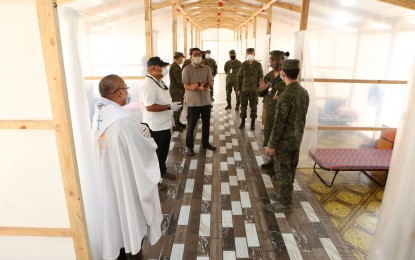
PATIENT CARE CENTERS. Armed Forces of the Philippines officials and private stakeholders take a look at the newly-constructed patient care center (PCC) at the Emmanuel Hospital in San Miguel, Bulacan on April 25, 2020. The AFP and its partners from the private sector have constructed 29 PCCs for Covid-19 patients since March 28. (Photo courtesy of AFP Public Affairs Office)
MANILA – The Armed Forces of the Philippines (AFP) on Friday announced that its various engineering units and other stakeholders have constructed 29 emergency patient care centers (PCCs) since last March 28.
“The Armed Forces of the Philippines extends its profound gratitude to our partners and stakeholders for their efforts to help our government fight the deadly Covid-19 (coronavirus disease 2019) through the construction of emergency quarantine facilities,” AFP Chief-of-Staff, Gen. Felimon Santos Jr., said in a statement.
AFP public affairs office chief, Navy Capt. Jonathan Zata said these PCCs are very essential in ongoing efforts to contain Covid-19 and are located within and outside Luzon.
The facilities were built through the efforts of the AFP Office of the Chief Engineer, led by Maj. Gen. William Ilagan, in partnership with the WTA Architecture and Design group, San Miguel Foundation, and other donors.
Ten PCCs were constructed inside military facilities under the WTA and Group Projects led by architect William Ti Jr. These are at the Manila Naval Hospital, General Headquarters Dispensary in Camp Aguinaldo and the V. Luna General Hospital, both in Quezon City; Philippine Air Force Hospital in Pasay City; Fernando Air Base in Batangas; Cavite Naval Hospital; and Army General Hospital and the Libingan ng mga Bayani, both in Taguig City.
Under the same project, nine of 49 PCCs in civilian facilities were constructed by teams of soldiers. These are in the Quezon City General Hospital; Ospital ng Muntinlupa in Muntinlupa City; Caloocan City Medical Center; Sta. Ana General Hospital in Manila; and the Bulacan Medical Center in Malolos, Sacred Heart Hospital, La Consolation University General Hospital, Emmanuel Hospital in San Miguel, and Baliuag District Hospital, all in Bulacan.
“In these unprecedented events, we are grateful (for) the kindness, generosity, and compassion from our stakeholders, especially to WTA, in supporting the AFP in its battle against the coronavirus disease. We dedicate our effort in accomplishing the emergency quarantine facilities to the community and to support our hospitals and medical workers, as they take the front line to combat Covid-19. We are one with you is in this battle,” Ilagan said.
Meanwhile, 10 PCCs were completed by engineering units under the San Miguel Foundation projects.
These include facilities in the Eastern Mindanao Command Hospital in Davao City, Central Command Hospital in Cebu City, Western Mindanao Command Hospital in Zamboanga City, and Western Command Hospital in Palawan.
In Davao City, a charitable group partnered with the AFP through the Eastern Mindanao Command to construct one PCC in the Southern Philippines Medical Center.
In Quezon City, engineering units completed three facilities for the AFP Health Service Command and two at the AFP General Headquarters Training School in Camp Aguinaldo.
A total of 11 more projects in Luzon are slated for construction by different engineering brigades and are expected to be completed before the enhanced community quarantine ends.
The PCCs are designed for hospitals and institutions that are at maximum capacity to provide proper facilities for patients who need to be quarantined.
These temporary structures are meant to increase the capacity of hospitals, and house patients suspected of having Covid-19 to keep them from spreading the infection. (PNA)
